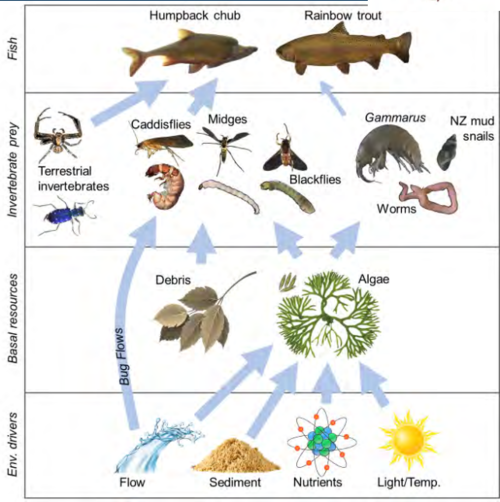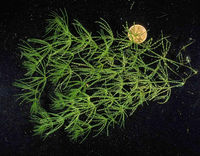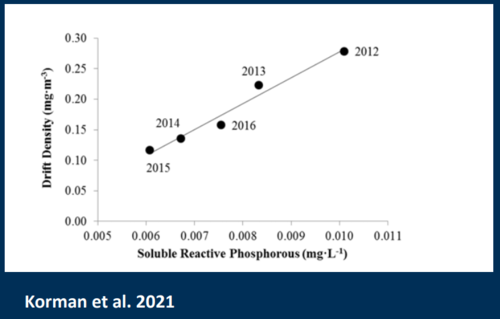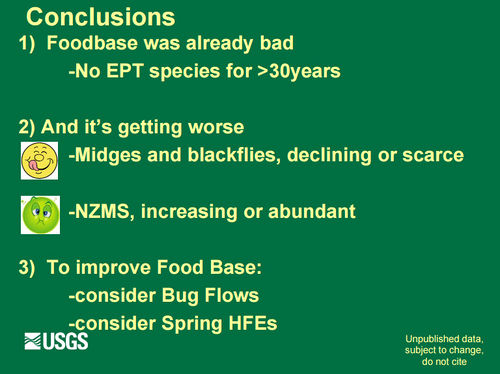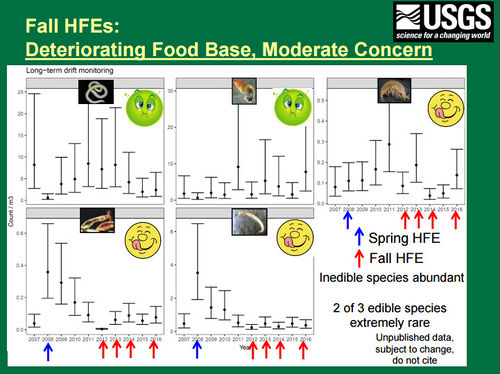Difference between revisions of "FOOD BASE"
Cellsworth (Talk | contribs) |
Cellsworth (Talk | contribs) |
||
| (76 intermediate revisions by the same user not shown) | |||
| Line 17: | Line 17: | ||
</table> | </table> | ||
| − | [[File: | + | [[File:FoodbaseModel.PNG|thumb|center|500px| https://www.usbr.gov/uc/progact/amp/twg/2022-01-13-twg-meeting/20220113-AnnualReportingMeeting-ProjectF-AquaticEcologyFoodBaseMonitoring-508-UCRO.pdf ]] |
<!-- | <!-- | ||
| Line 23: | Line 23: | ||
------------Portal list on righthand side----------> | ------------Portal list on righthand side----------> | ||
|style="width:60%; font-size:120%;"| | |style="width:60%; font-size:120%;"| | ||
| − | ==''' | + | =='''Aquatic Food Base monitoring below Glen Canyon Dam and into Grand Canyon'''== |
| − | + | Aquatic insects live in the water as larvae most of their lives, then emerge onto land for a brief period as winged adults. Sampling these emerged adults on land is therefore a useful tool for understanding the condition of the aquatic insect population that is in the water, particularly in large rivers where sampling the larvae on the river bed is impractical. Aquatic insects have a terrestrial, winged adult life stage in which they leave the water and fly onto land in order to find a mate and reproduce. [https://www.usgs.gov/centers/sbsc/science/aquatic-insects?qt-science_center_objects=0#qt-science_center_objects] | |
| − | ==[ | + | ==[http://gcdamp.com/index.php?title=Long-term_Experimental_and_Management_Plan_(LTEMP) '''LTEMP Resource Goal for the Aquatic Food Base''']== |
| + | No resource goal was identified for the aquatic food base. It was deemed more as "a means to an end" with regard to meeting goals for humpback chub, other native fish, and the rainbow trout fishery. | ||
| + | ==[[Portal:Desired Future Conditions -DFCs| '''Desired Future Condition for the Aquatic Food Base''']]== | ||
The aquatic food base will sustainably support viable populations of desired species at all trophic levels. Assure that an adequate, diverse, productive aquatic foodbase exists for fish and other aquatic and terrestrial species that depend on those food resources.<br> | The aquatic food base will sustainably support viable populations of desired species at all trophic levels. Assure that an adequate, diverse, productive aquatic foodbase exists for fish and other aquatic and terrestrial species that depend on those food resources.<br> | ||
| Line 37: | Line 39: | ||
! style="width=33%; background:#cedff2;" | [[File:EPT.jpg|center|500px]] [https://www.wcc.nrcs.usda.gov/ftpref/wntsc/strmRest/wshedCondition/EPTIndex.pdf EPT as Biologic Indicators of Stream Condition] <br> | ! style="width=33%; background:#cedff2;" | [[File:EPT.jpg|center|500px]] [https://www.wcc.nrcs.usda.gov/ftpref/wntsc/strmRest/wshedCondition/EPTIndex.pdf EPT as Biologic Indicators of Stream Condition] <br> | ||
! style="width=33%; background:#cedff2;" | [[File:Chara.jpg|center|200px]] [[Algae and Aquatic Macrophytes]] <br> | ! style="width=33%; background:#cedff2;" | [[File:Chara.jpg|center|200px]] [[Algae and Aquatic Macrophytes]] <br> | ||
| − | ! style="width=55%; background:#cedff2;" | [[File:Macroinvertebrates.jpg|center|400px]] [http:// | + | ! style="width=55%; background:#cedff2;" | [[File:Macroinvertebrates.jpg|center|400px]] [http://gcdamp.com/index.php?title=Aquatic_Macroinvertebrates Aquatic Macroinvertebrates] <br> |
|} | |} | ||
| Line 47: | Line 49: | ||
|style="color:#000;"| | |style="color:#000;"| | ||
| − | [[File: | + | [[File:NutrientsDrift.PNG|thumb|center|500px|Variable phosphorus release from Glen Canyon Dam controls tailwater food webs https://www.usbr.gov/uc/progact/amp/twg/2022-01-13-twg-meeting/20220113-AnnualReportingMeeting-pHRegulatesPhosphorusCyclingColoradoRiver-508-UCRO.pdf ]] |
| − | [[File:2017AR MidgeAbundance.jpg|center|500px | + | [[File:2017AR LCRbiomass.jpg|thumb|center|500px| https://www.usbr.gov/uc/rm/amp/twg/mtgs/17jan26/AR19_Kennedy.pdf ]] |
| − | [[File:2017AR FoodbaseConclusions.jpg|center|500px | + | [[File:2017AR MidgeAbundance.jpg|thumb|center|500px| https://www.usbr.gov/uc/rm/amp/twg/mtgs/17jan26/AR19_Kennedy.pdf ]] |
| − | [[File:2017AR HFEsFoodbase2.jpg|center|500px | + | [[File:2017AR FoodbaseConclusions.jpg|thumb|center|500px| https://www.usbr.gov/uc/rm/amp/twg/mtgs/17jan26/AR19_Kennedy.pdf ]] |
| + | [[File:2017AR HFEsFoodbase2.jpg|thumb|center|500px| https://www.usbr.gov/uc/rm/amp/twg/mtgs/17jan26/AR19_Kennedy.pdf ]] | ||
| + | [[File:Cross 2016.JPG|thumb|center|500px|[https://pubs.usgs.gov/fs/2013/3039/fs2013-3039.pdf Native and Nonnative Fish Populations of the Colorado River are Food Limited—Evidence from New Food Web Analyses] ]] | ||
|} | |} | ||
| Line 64: | Line 68: | ||
|style="color:#000;"| | |style="color:#000;"| | ||
| + | *[http://gcdamp.com/index.php?title=Portal:GCDAMP_Knowlege_Assessments GCMRC Annual Reports page] | ||
| + | *[http://gcdamp.com/index.php?title=Aquatic_Macroinvertebrates Aquatic Macroinvertebrates in Glen and Grand Canyons wiki page] | ||
| + | *[http://gcdamp.com/index.php?title=Algae_and_Aquatic_Macrophytes Algae and Aquatic Macrophytes wiki page] | ||
| + | *[http://gcdamp.com/index.php?title=Nutrients Nutrients wiki page] | ||
| + | *[http://gcdamp.com/index.php?title=Humpback_Chub_Page Humpback Chub wiki page] | ||
| + | *[http://gcdamp.com/index.php?title=FISHERY Lees Ferry Rainbow Trout Fishery wiki page] | ||
*[http://www.gcmrc.gov/research_areas/food_base/food_base_default.aspx GCMRC Aquatic Food Base Lab] | *[http://www.gcmrc.gov/research_areas/food_base/food_base_default.aspx GCMRC Aquatic Food Base Lab] | ||
*[http://www.usu.edu/buglab/ USU Buglab] | *[http://www.usu.edu/buglab/ USU Buglab] | ||
*[http://extension.usu.edu/waterquality/macrokey/ USU Aquatic Macroinvertebrate Key] | *[http://extension.usu.edu/waterquality/macrokey/ USU Aquatic Macroinvertebrate Key] | ||
*[http://www.dec.ny.gov/animals/35772.html Freshwater Macroinvertebrates of NY] | *[http://www.dec.ny.gov/animals/35772.html Freshwater Macroinvertebrates of NY] | ||
| − | |||
| − | |||
| − | |||
|- | |- | ||
| Line 84: | Line 91: | ||
[https://www.gcmrc.gov/research_areas/food_base/primary_production.aspx Measuring Primary Production in the Lees Ferry Reach] | [https://www.gcmrc.gov/research_areas/food_base/primary_production.aspx Measuring Primary Production in the Lees Ferry Reach] | ||
| − | + | [http://gcdamp.com/index.php?title=The_Bugflow_Experiment The BugFlow Experiment] | |
| − | + | ||
| + | [https://www.gcmrc.gov/research_areas/food_base/citizen_science_monitoring.aspx Citizen Science Insect Monitoring] | ||
Hyporheic Anoxia in the Lees Ferry Reach | Hyporheic Anoxia in the Lees Ferry Reach | ||
| Line 91: | Line 99: | ||
Downstream Recovery of the Foodbase Community in Several Colorado River Tailwaters | Downstream Recovery of the Foodbase Community in Several Colorado River Tailwaters | ||
| − | Drift and Food Availability Studies | + | [[Drift and Food Availability Studies]] |
| − | + | ||
| − | + | ||
|- | |- | ||
| Line 100: | Line 106: | ||
|style="color:#000;"| | |style="color:#000;"| | ||
| − | * | + | *2012 Foodbase PEP |
*[http://gcdamp.com/index.php?title=Foodbase_PEP 2004 Foodbase PEP] | *[http://gcdamp.com/index.php?title=Foodbase_PEP 2004 Foodbase PEP] | ||
| + | *[http://gcdamp.com/index.php?title=Foodbase_PEP 2001 Foodbase PEP] | ||
|- | |- | ||
| Line 107: | Line 114: | ||
|- | |- | ||
|style="color:#000;"| | |style="color:#000;"| | ||
| + | |||
| + | '''2023''' | ||
| + | *[https://doi.org/10.1139/cjfas-2022-0229 Hansen et al., 2023, Linking ecosystem processes to consumer growth rates—Gross primary productivity as a driver of freshwater fish somatic growth in a resource-limited river: Canadian Journal of Fisheries and Aquatic Sciences] | ||
| + | *[https://doi.org/10.1002/jwmg.22414 Metcalfe et al., 2023, Insectivorous bat foraging tracks the availability of aquatic flies (Diptera), The Journal of Wildlife Management] | ||
| + | *[https://doi.org/10.1002/tafs.10381 Yard et al., 2023, Declines in prey production during the collapse of a tailwater rainbow trout population are associated with changing reservoir conditions: Transactions of the American Fisheries Society] | ||
| + | *[https://www.usbr.gov/uc/progact/amp/twg/2023-01-26-twg-meeting/20230126-AnnualReportingMeeting-MolecularModelingToolsTrackingFoodBaseDynamicsChangingEnvironments-508-UCRO.pdf Molecular and modeling tools for tracking food base dynamics in changing environments] | ||
| + | *[[Media:BAO_Approved-LHansen-Rev_Poster.pdf| A Decade of GPP Data in a Changing River]] | ||
| + | *[[Media:Wehr-Wrey-Stevens_diatoms.pdf| Changes in epiphytic diatoms in the Colorado River downstream of Glen Canyon Dam following reduced flow variation]] | ||
| + | |||
| + | '''2022''' | ||
| + | *[https://www.usbr.gov/uc/progact/amp/amwg/2022-02-10-amwg-meeting/20220210-ProjectF-AquaticEcologyFoodBaseMonitoring-508-UCRO.pdf Project F: Aquatic ecology and food base monitoring ] | ||
| + | *[https://www.usbr.gov/uc/progact/amp/twg/2022-01-13-twg-meeting/20220113-AnnualReportingMeeting-ProjectF-AquaticEcologyFoodBaseMonitoring-508-UCRO.pdf Project F: Aquatic ecology and food base monitoring ] | ||
| + | |||
| + | '''2021''' | ||
| + | *[[Media:Abernethy 2021 Hydropeaking intensity.pdf| Abernethy et al., 2021, Hydropeaking intensity and dam proximity limit aquatic invertebrate diversity in the Colorado River Basin: Ecosphere]] | ||
| + | *[https://www.usbr.gov/uc/progact/amp/twg/2021-04-14-twg-meeting/20210414-MacroinvertebrateOvipositionHabitatSelectivityEgg-MassDesiccationTolerances-508-UCRO.pdf Macroinvertebrate Oviposition Habitat Selectivity and Egg-Mass Desiccation Tolerances: Implications For Population Dynamics In Large Regulated Rivers ] | ||
| + | *[https://www.usbr.gov/uc/progact/amp/twg/2021-04-14-twg-meeting/20210414-DistributionImpactsBenthicHyporheicAnoxiaColoradoRiverEcosystem-508-UCRO.pdf Distribution and Impacts of Benthic and Hyporheic Anoxia on the Colorado River Ecosystem Downstream from Glen Canyon Dam, Arizona ] | ||
| + | *[https://www.usbr.gov/uc/progact/amp/amwg/2021-02-11-amwg-meeting/20210211-NutrientsPrimaryProductionColoradoRiverFoodbase-508-UCRO.pdf Nutrients, Primary Production, and the Colorado River Foodbase ] | ||
| + | |||
| + | '''2020''' | ||
| + | *[https://www.sryahwapublications.com/annals-of-ecology-and-environmental-science/pdf/v4-i2/1.pdf Stevens et al. 2020. Benthic discontinuity between an unregulated tributary and the dam-controlled Colorado River, Grand Canyon, Arizona. Annals of Ecology and Environmental Science.] | ||
| + | *[https://doi.org/10.1111/fwb.13617 Metcalfe et al., 2020, Net‐spinning caddisfly distribution in large regulated rivers: Freshwater Biology] | ||
| + | *[https://www.usbr.gov/uc/progact/amp/twg/2020-10-15-twg-meeting/20201015-ColoradoRiverAquaticFoodbaseStudiesTapeatsCreek-Presentation-508-UCRO.pdf Colorado River Aquatic Foodbase Studies at Tapeats Creek, Grand Canyon National Park, Arizona: A Benthic Discontinuity ] | ||
| + | *[https://www.usgs.gov/mission-areas/ecosystems/science/episode-2-citizen-science?qt-science_center_objects=0#qt-science_center_objects Citizen Science - podcast ] | ||
| + | *[[Media:Metcalfe 2020 Spatial population structure aquatic insect CR Basin.pdf|Metcalfe et al., 2020, Spatial population structure of a widespread aquatic insect in the Colorado River Basin--Evidence for a Hydropsyche oslari species complex: Freshwater Science]] | ||
| + | *[https://www.usbr.gov/uc/progact/amp/twg/2020-01-13-twg-meeting/20200113-AnnualReportingMeeting-TroutRecruitmentGrowthPopulationDynamics-Presentation-508-UCRO.pdf TRGD: Trout Recruitment, Growth and Population Dynamics ] | ||
| + | |||
| + | '''2019''' | ||
| + | *[https://esajournals.onlinelibrary.wiley.com/doi/10.1002/ecs2.2583 Behn, K. E., and C. V. Baxter. 2019. The trophic ecology of a desert river fish assemblage: influence of season and hydrologic variability. Ecosphere 10(1):e02583] | ||
| + | *[https://www.usbr.gov/uc/progact/amp/twg/2019-03-14-twg-meeting/20190314-BigFloodSmallFloodSpringFloodFallFloodHFETimingAffectsFoodBaseResponse-Presentation-508-UCRO.pdf Big Flood, Small Flood, Spring Flood, Fall Flood: HFE timing affects food base response? Presentation ] | ||
| + | |||
| + | '''2018''' | ||
| + | *[https://www.usbr.gov/uc/progact/amp/twg/2018-10-10-twg-meeting/Attach_09.pdf Future CRE Foodbase Research and Management PPT] | ||
| + | *[[Media:Ellsworth TWG Meeting 20180626.pdf| Caddisfly outbreak on the Colorado River below Davis Dam Laughlin NV / Bullhead City AZ]] | ||
| + | *[https://www.usbr.gov/uc/rm/amp/twg/mtgs/18jun25/Attach_12.pdf Colorado River Benthic Foodbase Studies in Glen and Grand Canyons PPT (Tapeats Creek study)] | ||
| + | *[https://www.usbr.gov/uc/rm/amp/twg/mtgs/18jan25/AR09.pdf Shedding light on aquatic insects of the Colorado River Basin with citizen science PPT] | ||
| + | *[https://www.usbr.gov/uc/rm/amp/twg/mtgs/18jan25/AR08.pdf Colorado River Benthic Foodbase Studies in Glen and Grand Canyons: Anoxic substrates and Tapeats Creek studies PPT] | ||
| + | *[https://www.lcrmscp.gov/crab/presentations/2018/crab18_21.pdf Aquatic invertebrate drift patterns downstream of Colorado River Basin dams] | ||
| + | *[http://dx.doi.org/10.1111/1365-2664.13109 Sabo et al., 2018, Pulsed flows, tributary inputs, and food web structure in a highly regulated river: Journal of Applied Ecology ] | ||
'''2017''' | '''2017''' | ||
| + | *[https://doi.org/10.1086/694539 Walters et al., 2017, A digital reference collection for aquatic macroinvertebrates of North America: Freshwater Science, v. 36, no. 4, p. 693-697] | ||
*[http://dx.doi.org/10.1139/cjfas-2016-0365 Muehlbauer et al. 2016. Deleterious effects of net clogging on the quantification of stream drift: Canadian Journal of Fisheries and Aquatic Sciences] | *[http://dx.doi.org/10.1139/cjfas-2016-0365 Muehlbauer et al. 2016. Deleterious effects of net clogging on the quantification of stream drift: Canadian Journal of Fisheries and Aquatic Sciences] | ||
*[https://www.usbr.gov/uc/rm/amp/twg/mtgs/17jan26/AR18_Muehlbauer.pdf Fluvial Aquatic Ecology of the Colorado River (… especially Lees Ferry)] | *[https://www.usbr.gov/uc/rm/amp/twg/mtgs/17jan26/AR18_Muehlbauer.pdf Fluvial Aquatic Ecology of the Colorado River (… especially Lees Ferry)] | ||
| Line 120: | Line 167: | ||
'''2015''' | '''2015''' | ||
| + | *[http://www.montana.edu/wcross/documents/publication/Walters-et-al-2015.pdf Walters et al. 2015. Mercury and selenium accumulation in the Colorado River food web, Grand Canyon, USA. Environmental Toxicology and Chemistry] | ||
| + | *[https://www.usbr.gov/uc/progact/amp/twg/2015-10-20-twg-meeting/Attach_08b.pdf Mercury and Selenium levels in the Grand Canyon foodweb] | ||
*[http://www.usbr.gov/uc/rm/amp/twg/mtgs/15jan20/Attach_11.pdf Invertebrate drift in Glen Canyon 2007-2013] | *[http://www.usbr.gov/uc/rm/amp/twg/mtgs/15jan20/Attach_11.pdf Invertebrate drift in Glen Canyon 2007-2013] | ||
| Line 130: | Line 179: | ||
'''2013''' | '''2013''' | ||
| + | *[https://pubs.usgs.gov/fs/2013/3039/fs2013-3039.pdf Native and Nonnative Fish Populations of the Colorado River are Food Limited—Evidence from New Food Web Analyses] | ||
| + | *[http://www.montana.edu/wcross/documents/publication/Cross%20et%20al.%202013.pdf Cross et al. 2013. Food-web dynamics in a large river discontinuum. Ecological Monographs] | ||
*[http://www.gcmrc.gov/about/foodbase/Kennedy%20et%20al.%20FWB%20proofs.pdf Kennedy et al. 2013. The relation between invertebrate drift and two primary controls, discharge and benthic densities, in a large regulated river. Freshwater Biology.] | *[http://www.gcmrc.gov/about/foodbase/Kennedy%20et%20al.%20FWB%20proofs.pdf Kennedy et al. 2013. The relation between invertebrate drift and two primary controls, discharge and benthic densities, in a large regulated river. Freshwater Biology.] | ||
| − | *[http://www.uwyo.edu/bhall/reprints/wellard_kelly2013.pdf Wellard-Kelly et al. 2013. Macroinvertebrate diets reflect tributary inputs and turbidity-driven changes in food availability in the Colorado River downstream of Glen Canyon Dam. Freshwater Science | + | *[http://www.uwyo.edu/bhall/reprints/wellard_kelly2013.pdf Wellard-Kelly et al. 2013. Macroinvertebrate diets reflect tributary inputs and turbidity-driven changes in food availability in the Colorado River downstream of Glen Canyon Dam. Freshwater Science.] |
| − | *[[Media:Miller and Judson-2013-DriftAndHydropeaking.pdf| Miller and Judson. 2013. Responses of macroinvertebrate drift, benthic assemblages, and trout foraging to hydropeaking. Can. J. Fish. Aquat. Sci. | + | *[[Media:Miller and Judson-2013-DriftAndHydropeaking.pdf| Miller and Judson. 2013. Responses of macroinvertebrate drift, benthic assemblages, and trout foraging to hydropeaking. Can. J. Fish. Aquat. Sci.]] |
*[http://www.usbr.gov/uc/rm/amp/twg/mtgs/13nov06/Attach_02a.pdf GCMRC Update - Status of Resources and Sediment Conditions] | *[http://www.usbr.gov/uc/rm/amp/twg/mtgs/13nov06/Attach_02a.pdf GCMRC Update - Status of Resources and Sediment Conditions] | ||
*[http://www.gcmrc.gov/about/annaul_reporting/Tuesday%201_22_13/6.%20Kennedy_2013Annual%20Report.pdf Annual Reporting Meeting: Foodbase Update] | *[http://www.gcmrc.gov/about/annaul_reporting/Tuesday%201_22_13/6.%20Kennedy_2013Annual%20Report.pdf Annual Reporting Meeting: Foodbase Update] | ||
| Line 146: | Line 197: | ||
'''2011''' | '''2011''' | ||
| − | *[http://www.gcmrc.gov/about/foodbase/Cross%20et%20al.%202011_EA.pdf | + | *[http://www.gcmrc.gov/about/foodbase/Cross%20et%20al.%202011_EA.pdf Cross et al. 2011. Ecosystem ecology meets adaptive management: Food web response to a controlled flood on the Colorado River, Glen Canyon. Ecological Applications, 21(6), 2011, pp. 2016–2033] |
'''2010''' | '''2010''' | ||
| + | *[[Media:2010 Rosi HFEs Foodbase.pdf| Rosi-Marshall et al., 2010, Short-term effects of the 2008 high-flow experiment on macroinvertebrates in the Colorado River below Glen Canyon Dam, Arizona: U.S. Geological Survey Open-File Report 2010-1031, 28 p.]] | ||
| + | *[https://pdfs.semanticscholar.org/a521/0fc25d8781a5511fbb50947f8a38c9c5ded2.pdf Wellard-Kelly, 2010, Resource Composition and Macroinvertebrate Resource Consumption in the Colorado River Below Glen Canyon Dam. Master's Theses. ] | ||
| + | *[https://www.gcmrc.gov/library/reports/biological/Foodbase/McKinney1999f.pdf McKinney et al., 2010, Macroinvertebrate drift in the tailwater of a regulated river below Glen Canyon Dam, Arizona. The Southwestern Naturalist] | ||
*[http://www.montana.edu/wcross/Cross_website/Publications_files/Cross%20et%20al.%202010.pdf Cross et al. 2010. Invasion and production of New Zealand mud snails in the Colorado River, Glen Canyon. Biol Invasions] | *[http://www.montana.edu/wcross/Cross_website/Publications_files/Cross%20et%20al.%202010.pdf Cross et al. 2010. Invasion and production of New Zealand mud snails in the Colorado River, Glen Canyon. Biol Invasions] | ||
*[http://pubs.usgs.gov/of/2010/1031/of2010-1031.pdf Short-Term Effects of the 2008 High-Flow Experiment on Macroinvertebrates in Colorado River Below Glen Canyon Dam, Arizona] | *[http://pubs.usgs.gov/of/2010/1031/of2010-1031.pdf Short-Term Effects of the 2008 High-Flow Experiment on Macroinvertebrates in Colorado River Below Glen Canyon Dam, Arizona] | ||
*[http://pubs.usgs.gov/of/2010/1075/of2010-1075.pdf Basal Resources in Backwaters of the Colorado River Below Glen Canyon Dam—Effects of Discharge Regimes and Comparison with Mainstem Depositional Environments] | *[http://pubs.usgs.gov/of/2010/1075/of2010-1075.pdf Basal Resources in Backwaters of the Colorado River Below Glen Canyon Dam—Effects of Discharge Regimes and Comparison with Mainstem Depositional Environments] | ||
| − | ''' | + | '''2009''' |
| − | *[ | + | *[https://scholarsarchive.byu.edu/cgi/viewcontent.cgi?article=2122&context=wnan Blinn and Ruiter, 2009, "Caddisfly (Trichoptera) assemblages along major river drainages in Arizona," Western North American Naturalist] |
| + | *[https://www.gcmrc.gov/library/reports/physical/hydrology/Oberlin1999.pdf Oberlin et al., 2009, Watershed Influence on the Macroinvertebrate Fauna of Ten Major Tributaries of the Colorado River through Grand Canyon, Arizona. The Southwestern Naturalist] | ||
| + | *[https://www.usbr.gov/uc/rm/amp/amwg/mtgs/09apr29/Attach_03a.pdf AIF: Grand Canyon Monitoring and Research Center (GCMRC) Update] | ||
| + | *[https://www.usbr.gov/uc/rm/amp/twg/mtgs/09mar16/Attach_05.pdf Grand Canyon Monitoring and Research Center updates by Program Managers] | ||
| + | |||
| + | '''2003''' | ||
| + | *[[Media:2003 Haden benthic structure CR.pdf| Haden et al. 2003. Benthic community structure of the Green and Colorado Rivers through Canyonlands National Park, Utah, USA. The Southwestern Naturalist]] | ||
'''2001''' | '''2001''' | ||
| Line 163: | Line 223: | ||
'''1999''' | '''1999''' | ||
| + | *Oberlin, G. E., J. P. Shannon, and D. W. Blinn. 1999. Watershed influence on the macroinvertebrate fauna of ten major tributaries of the Colorado River through Grand Canyon, Arizona. Southwestern Naturalist 44:17–30. | ||
| + | *Haden, G. A., D. W. Blinn, and J. P. Shannon. 1999. Driftwood: an alternative habitat for macroinvertebrates in a large southwestern river. Hydrobiologia 397:179–186. | ||
*[http://www.gcmrc.gov/library/reports/biological/Foodbase/Oberlin1999.pdf Oberlin et al. Watershed influence on the macroinvertebrate fauna of ten major tributaries of the Colorado River through Grand Canyon, Arizona. The Southwestern Naturalist 44(1):17-30. ] | *[http://www.gcmrc.gov/library/reports/biological/Foodbase/Oberlin1999.pdf Oberlin et al. Watershed influence on the macroinvertebrate fauna of ten major tributaries of the Colorado River through Grand Canyon, Arizona. The Southwestern Naturalist 44(1):17-30. ] | ||
'''1998''' | '''1998''' | ||
| + | *Stevens, L. E., J. P. Shannon, and D. W. Blinn. 1998. Colorado river benthic ecology in Grand Canyon, Arizona, USA: dam, tributary and geomorphological influences. Regulated Rivers. | ||
*[https://www.gcmrc.gov/library/reports/biological/Foodbase/Blinn1998b.pdf Blinn et al. 1998. Algal ecology in the tailwater stream communities: The Colorado River below Glen Canyon Dam, Arizona. J, Phycol. M, 734-740 (1998)] | *[https://www.gcmrc.gov/library/reports/biological/Foodbase/Blinn1998b.pdf Blinn et al. 1998. Algal ecology in the tailwater stream communities: The Colorado River below Glen Canyon Dam, Arizona. J, Phycol. M, 734-740 (1998)] | ||
*[http://scholarsarchive.byu.edu/cgi/viewcontent.cgi?article=3242&context=gbn Stevens et al. 1998. Chironomidae (Diptera) of the Colorado River, Grand Canyon, Arizona, USA, II: factors influencing distribution. Great Basin Naturalist: Vol. 58: No. 2, Article 2] | *[http://scholarsarchive.byu.edu/cgi/viewcontent.cgi?article=3242&context=gbn Stevens et al. 1998. Chironomidae (Diptera) of the Colorado River, Grand Canyon, Arizona, USA, II: factors influencing distribution. Great Basin Naturalist: Vol. 58: No. 2, Article 2] | ||
'''1997''' | '''1997''' | ||
| + | *Stevens, L. E., J. P. Shannon, and D. W. Blinn. 1997. Colorado River benthic ecology in Grand Canyon, Arizona, USA: dam, tributary and geomorphological influences. Regulated Rivers: Research and Management 13:129–149. | ||
*[http://www.riversimulator.org/Resources/GCMRC/PhysicalResources2/Shaver1997.pdf Shaver et al. Effects of suspended sediment and desiccation on the benthic tailwater community in the Colorado River, USA. Hydrobiologia 357: 63–72, 1997. ] | *[http://www.riversimulator.org/Resources/GCMRC/PhysicalResources2/Shaver1997.pdf Shaver et al. Effects of suspended sediment and desiccation on the benthic tailwater community in the Colorado River, USA. Hydrobiologia 357: 63–72, 1997. ] | ||
*[http://www.academia.edu/29251275/Colorado_River_benthic_ecology_in_Grand_Canyon Stevens et al. 1997. Colorado River benthic ecology in Grand Canyon, Arizona, USA: Dam, tributary, and gomorphological influences. Regulated Rivers: Research and Management, Vol. 13, 129–149 (1997)] | *[http://www.academia.edu/29251275/Colorado_River_benthic_ecology_in_Grand_Canyon Stevens et al. 1997. Colorado River benthic ecology in Grand Canyon, Arizona, USA: Dam, tributary, and gomorphological influences. Regulated Rivers: Research and Management, Vol. 13, 129–149 (1997)] | ||
| Line 179: | Line 243: | ||
*[http://www.riversimulator.org/Resources/GCMRC/FoodBase/Haury1991.pdf Haury 1991. Zooplankton of the Colorado River: Glen Canyon Dam to Diamond Creek] | *[http://www.riversimulator.org/Resources/GCMRC/FoodBase/Haury1991.pdf Haury 1991. Zooplankton of the Colorado River: Glen Canyon Dam to Diamond Creek] | ||
*[https://www.gcmrc.gov/library/reports/gces/Blinn1991.pdf Blinn and Cole. 1991. Algal and Invertebrate Biota in the Colorado River: Comparison of Pre- and Post-Dam Conditions. In Colorado River Ecology and Dam Management.] | *[https://www.gcmrc.gov/library/reports/gces/Blinn1991.pdf Blinn and Cole. 1991. Algal and Invertebrate Biota in the Colorado River: Comparison of Pre- and Post-Dam Conditions. In Colorado River Ecology and Dam Management.] | ||
| + | |||
| + | '''1990''' | ||
| + | *[https://www.nap.edu/read/1832/chapter/8 Blin and Cole, 1990, Algal and Invertebrate Biota in the Colorado River: Comparison of Pre- and Post-Dam Conditions] | ||
'''1981''' | '''1981''' | ||
| Line 191: | Line 258: | ||
|style="color:#000;"| | |style="color:#000;"| | ||
| − | + | ===The interaction of fish, foodbase, and temperature=== | |
| − | + | Fish occupying warmer water have higher metabolic demands than individuals in cooler water, and if these demands increase concurrently with a seasonal decline in prey availability, then growth rates may be reduced. [http://wec.ufl.edu/floridarivers/NSE/Finch%20RRA%20HBC%20Growth%20NSE.pdf] | |
| − | + | ||
| − | + | ||
| − | + | ||
| + | ---- | ||
| + | *Gammarus, blackflies, and midges fuel fish production below Glen Canyon Dam. | ||
| + | *Blackflies and midges respond positively to spring HFE's. Gammarus show little response to fall or spring HFEs. | ||
| + | *Mud Snails were introduced below Glen Canyon Dam around 1995. | ||
| + | |||
|} | |} | ||
| − | |||
| − | |||
| − | |||
Latest revision as of 17:22, 25 April 2024
|
|
Aquatic Food Base monitoring below Glen Canyon Dam and into Grand CanyonAquatic insects live in the water as larvae most of their lives, then emerge onto land for a brief period as winged adults. Sampling these emerged adults on land is therefore a useful tool for understanding the condition of the aquatic insect population that is in the water, particularly in large rivers where sampling the larvae on the river bed is impractical. Aquatic insects have a terrestrial, winged adult life stage in which they leave the water and fly onto land in order to find a mate and reproduce. [1] LTEMP Resource Goal for the Aquatic Food BaseNo resource goal was identified for the aquatic food base. It was deemed more as "a means to an end" with regard to meeting goals for humpback chub, other native fish, and the rainbow trout fishery. Desired Future Condition for the Aquatic Food BaseThe aquatic food base will sustainably support viable populations of desired species at all trophic levels. Assure that an adequate, diverse, productive aquatic foodbase exists for fish and other aquatic and terrestrial species that depend on those food resources. |
| EPT as Biologic Indicators of Stream Condition |
Algae and Aquatic Macrophytes |
Aquatic Macroinvertebrates |
|---|
